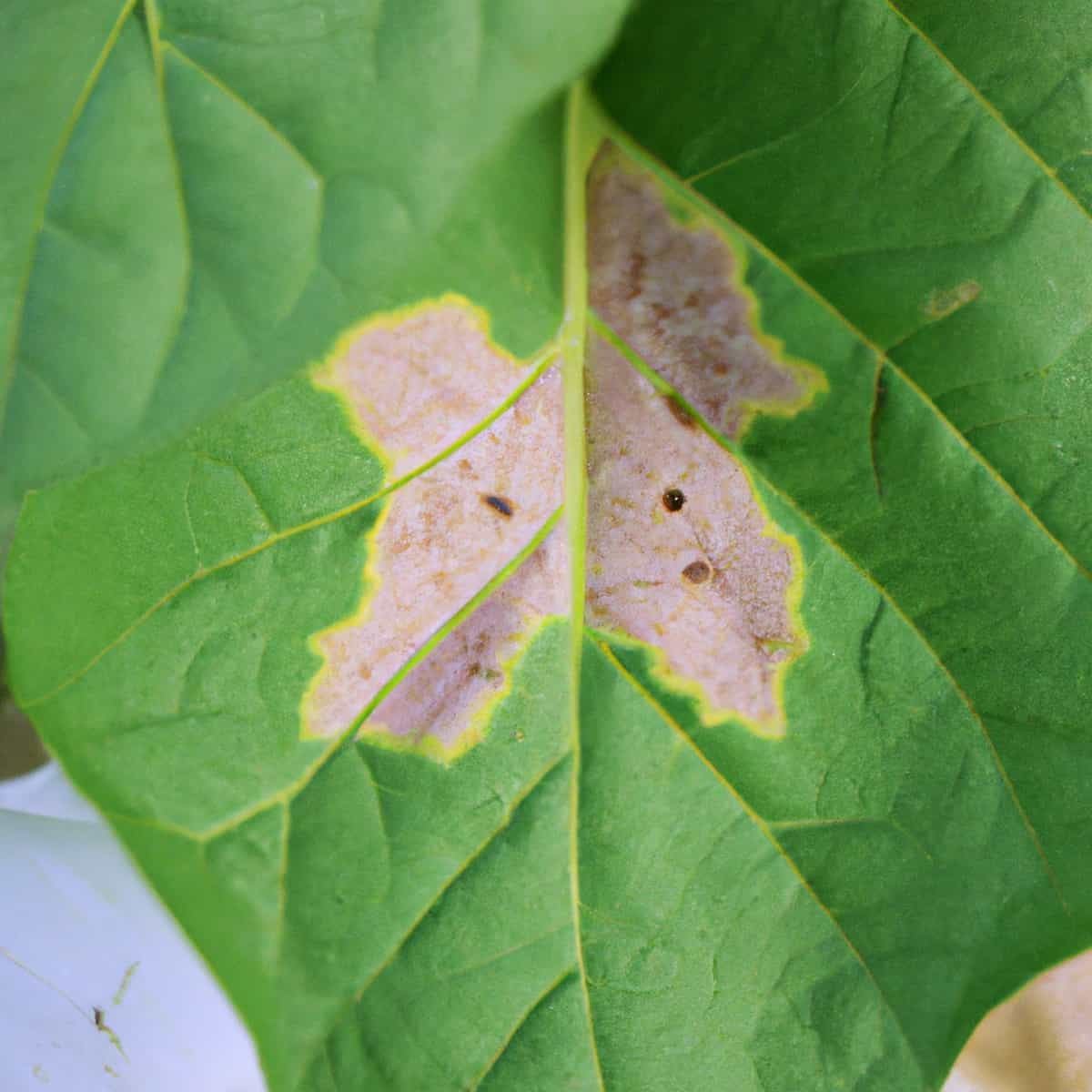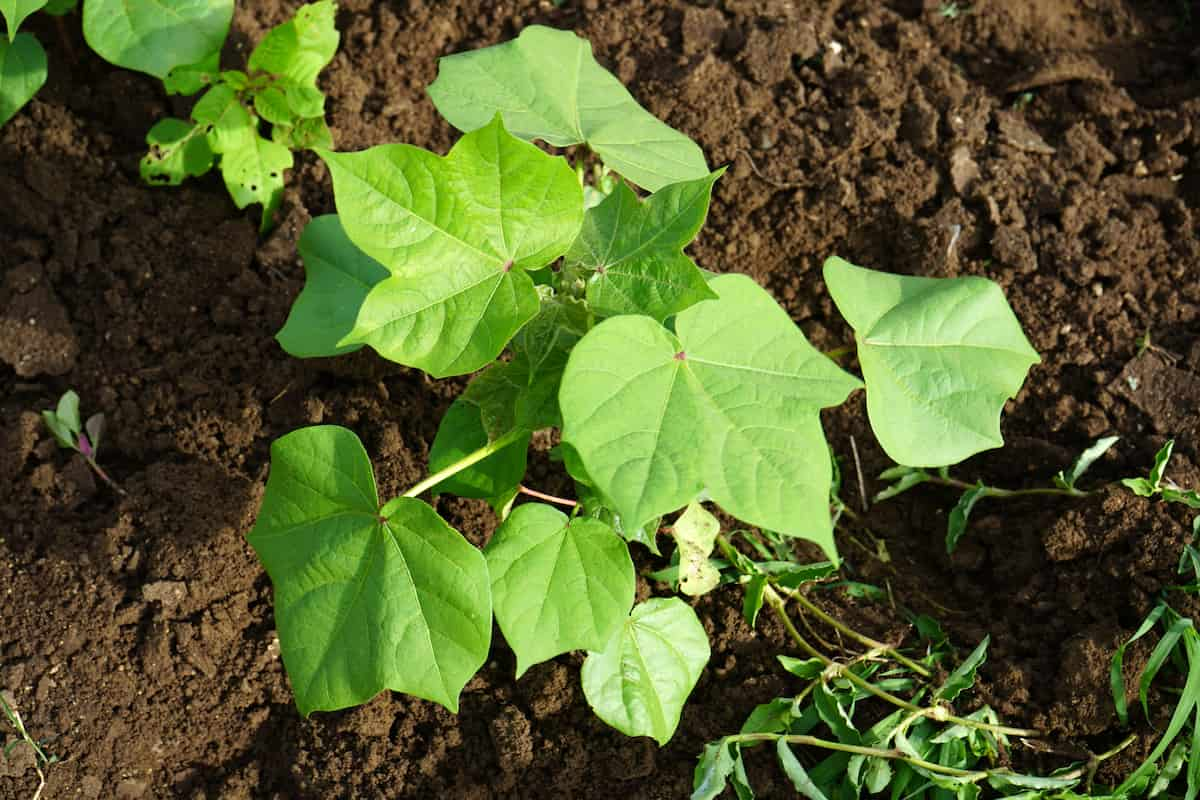Tobacco Streak Virus (TSV) is a plant virus of the Bromoviridae family and the genus Ilarvirus. It has a diverse host range, with over 200 vulnerable species, and is most harmful in warm, tropical areas. TSV does not usually produce broad outbreaks, although it can cause severe damage to sunflowers, cotton in India and Australia, and peanuts in India. TSV infects plants via wounds and can produce symptoms such as leaf yellowing and stunting, decreased blooming and boll output, and leaf necrosis.

Tobacco Streak Virus Management in Cotton
The Causal Organism of Tobacco Streak Virus
Tobacco Streak Virus (TSV) is the causative agent of a plant disease that affects a variety of plant hosts, including tobacco, asparagus, strawberries, soybeans, and sunflowers. Infected seeds are the primary source of infection. Secondary transmission from plant to plant occurs by vector pests (aphids or thrips) or mechanical harm to the plants during field operations.
The Disease Cycle of Tobacco Streak Virus
TSV (Tobacco Streak Virus) is an ss-RNA virus that infects cotton plants and causes harm to yield and plant growth. Spheroid particles of coat protein subunits encase an ss-RNA genome. The coat protein components are important in the virus’s life cycle, preserving the viral DNA and permitting cell-to-cell migration. Once within the host cell, the virus uncoils and releases its viral genomic RNA into the cytoplasm, where it is reproduced and expressed.
The new virus particles are then constructed when the dsRNA genome is produced from the genomic ssRNA. TSV may infect cotton plants by various routes, including thrips vectors, mechanical injury, pollen, or dodder. It requires a live plant to survive, and once systemic, it may cause considerable crop damage.
Causes/conditions Favorable for Tobacco Streak Virus Disease Spread in the Field.
- TSV causes yellowing and stunting of leaves, decreased blooming and boll development, and leaf necrosis in infected plants, resulting in poorer yields and plant growth.
- The severe symptoms of disease and their impact on yield are determined by plant type, climatic circumstances (temperature and humidity), and the plant’s growth stage when infected.
- TSV spreads in the field via infected seeds and vector pests like aphids and thrips. Warm and humid surroundings, as well as late infestations by aphids, are ideal for the spread of TSV illness.
Symptoms of Tobacco Streak Virus Disease
- Cotton plants are affected by Tobacco Streak Virus Disease, which produces a variety of symptoms. The following are the major symptoms to look out for:
- Small chlorotic patches: Infected plants first exhibit tiny, uneven yellow or discolored spots on the leaves approximately 2-5 mm in diameter.
- Large angular chlorotic or necrotic patches get larger over time, ranging in size from 5 to 15 mm in diameter, and produce an uneven mosaic pattern on the leaves.
- Leaf necrosis and early shedding: Necrotic leaves may fall off prematurely, resulting in a lower canopy and stunting of the plant.
- Reduced flowering and boll drop: The quantity of flowers on infected plants is reduced, and bolls may drop off early, decreasing yields significantly.
- Yellow, thickened, and distorted veins: Infected leaves’ veins become yellow, thickened, and malformed.
- Symptoms on younger leaves: Symptoms are more common on younger leaves, which seem paler and stunted than healthy ones.
- Paler look in infected regions: Affected areas seem paler in the field, with fewer leaves and stunted development.
In case you missed it: Root Rot Disease Management in Cotton: Symptoms, Treatment, Chemical, Biological, Natural, and Organic Control

Impact of Tobacco Streak Virus Disease Management on Cotton
The tobacco streak virus (TSV) can significantly disrupt cotton production. Stunted development, decreased flowering and boll output, and leaf necrosis can all result in reduced yields and plant growth. TSV on cotton fields can be reduced with effective management tactics such as employing healthy planting material, stringent hygiene practices, and vector control.
Tobacco Streak Virus Disease Management in Cotton by Cultural Method
- Remove and burn the infected plant materials and bolls in the soil.
- Rogue out the weed hosts.
- Install Sticky traps to control the vector.
- Control vector population by trapping and border crops
- To handle Tobacco Streak Virus (TSV) disease in cotton, utilize an integrated approach.
- Preventive measures such as crop rotation and planting resistant types should be paired with biological treatments to get the greatest outcomes.
- Natural remedies, for example, may involve the use of beneficial insects like as predators or parasites to control thrips populations, which can assist in minimizing viral propagation.
Tobacco Streak Virus Disease Management in Cotton by The Chemical Method
- Direct treatment of viral diseases like the Tobacco Streak Virus (TSV) is impossible. However, the spread of the virus through vectors like thrips and aphids can be managed through chemical control measures.
- Chemical treatments such as fipronil (2 ml/l) or thiamethoxam (0.2 g/l) might be utilized to control these insects. Acephate at 450 g/acre can also control TSV illness in cotton. When utilizing chemical controls for vector control, following the label recommendations and taking the required precautions is critical.
In case you missed it: Verticillium Wilt Management in Cotton: Disease Symptoms, Treatment, Chemical, Biological, Natural, and Organic Control

Preventive Measures for Control of Disease Tobacco Streak Virus
- Use healthy planting material from trustworthy sources.
- Implement strict hygiene practices with all tools used in cotton cultivation.
- Regularly inspect the plants or fields for signs of the disease and its vectors, like thrips and aphids.
- Remove infected plants and dispose of them properly.
- Do not transfer suckers between fields.
- Avoid planting alternative hosts of TSV, such as asparagus, strawberry, soybean, sunflowers, lettuce, and tobacco, near the cotton field.
- Implementing these preventive measures can effectively control the spread of TSV.
Conclusion
Tobacco Streak Virus (TSV) is a serious disease that affects cotton production. A combination of cultural methods, such as crop rotation and planting resistant varieties, with biological treatments and monitoring can help to manage TSV in cotton effectively.
An integrated approach combining preventive measures and treatments can help reduce the impact of the disease on cotton yields and quality. Using natural and organic control methods, such as reducing thrips populations with beneficial insects, can also contribute to sustainable disease management.
- Natural Solutions for Pest Control in Flower Gardens
- Types of Fungicides Used in Agriculture
- Common Issues in the Fruit Development Stage of Pomegranate Farming
- Fruit Development Issues in Papaya: Easy Solutions and Treatment
- Soil-Borne Diseases and How to Protect Your Plants
- Practices to Prevent Disease Spread in the Garden
- From Wilted to Thriving: How to Treat Root Rot Naturally in Houseplants
- Natural Remedies to Cure Brown Spots on Fig Tree Leaves
- Natural Solutions for Poinsettia Problems: 100% Effective Remedies